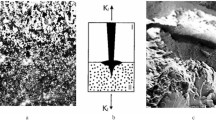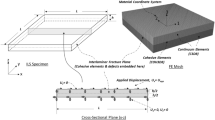Abstract
We have studied the effect of residual stresses on fracture resistance and crack arrest behavior of asymmetric ceramic laminated Si 3 N 4/Si 3 N 4–TiN structures. Using the compliance method, we assessed the technique of R-curve construction for laminar composites. For laminar structures with layers varying by their elastic characteristics we developed an analytical method for calculation of “fracture resistance – crack length” dependence. The method applicability is verified by calculation of stress intensity factors for laminar specimens with an edge crack. The calculated results are compared to the experimental data.
Similar content being viewed by others
REFERENCES
M. Chan, "Layered ceramics: processing and mechanical behavior," Ann. Rev. Mater. Sci., 27, 249–282 (1997).
W. J. Clegg, K. Kendall, N. McN Alford, et al., "A simple way to make tough ceramics," Nature, 347, 455–457 (1990).
R. Lakshminarayanan, D. K. Shetty, and R. A. Cutler, "Toughening of layered ceramic composites with residual surface compression," J. Amer. Ceram. Soc., 79, No. 1, 79–87 (1996).
N. Lugovoi, N. Orlovskaya, V. Slyunyayev, et al., "Crack bifurcation features in laminar specimens with fixed total thickness," Comp. Sci. Tech., 62, 819–830 (2002).
D. B. Marshall, J. J. Ratto, and F. F. Lange, "Enhanced fracture toughness in layered microcomposites of CeO-ZrO2 and Al2O3," J. Amer. Ceram. Soc., 74, No. 12, 2979–2987 (1991).
N. Lugovoi, N. Orlovskaya, K. Berroth, and J. Kuebler, "Macrostructural engineering of ceramic-matrix layered composites," Comp. Sci. Tech., 59, 1429–1437 (1999).
A. J. Blattner, R. Lakshminarayanan, and D. K. Shetty, "Toughening of layered ceramic composites with residual surface compression: effects of layer thickness," Eng. Fract. Mech., 68, 1–7 (2001).
A. G. Evans, "Perspective on the development of high-toughness ceramics," J. Amer. Ceram. Soc., 73, No. 2, 187–206 (1990).
V. M. Sglavo, L. Larentis, and D. J. Green, "Flaw-insensitive ion-exchanged glass: I, theoretical aspects," J. Amer. Ceram. Soc., 84, No. 8, 1827–1831 (2001).
R. J. Moon, M. Hoffman, J. Hilden, et al., "Weight function analysis on the R-curve behavior of multilayered alumina-zirconia composites," J. Amer. Ceram. Soc., 85, No. 6, 1505–1511 (2002).
T. Fett and D. Munz, "Influence of crack-surface interactions on stress intensity factor in ceramics," J. Mater. Sci. Lett., 9, 1403–1406 (1990).
S. P. Timoshenko and J. N. Goodier, Theory of Elasticity, 3rd edn., McGraw-Hill, New York (1970).
A. E. Giannakopoulos, S. Suresh, M. Finot, and M. Olsson, "Elastoplastic analysis of thermal cycling: layered materials with compositional gradients," Acta Metall. Mater., 43, No. 4, 1335–1354 (1995).
V. Sergo, D. M. Lipkin, G. de Portu, and D. R. Clarke, "Edge stresses in alumina/zirconia laminate," J. Amer. Ceram. Soc., 80, No. 7, 1633–1638 (1997).
J. E. Srawley, "Wide range stress intensity factor expressions for ASTM E 399 standard fracture toughness specimens," Int. J. Fract., 12, 475–476 (1976).
N. A. Orlovskaya, J. Kuebler, V. I. Subotin, and N. I. Lugovoi, "High toughness ceramic laminates by design of residual stresses," in: F. T. Wallenberger, N. Weston, K. Chawla, R. Ford, and R. P. Wool (Eds.), 2001 Fall Meeting Proceedings, Vol. 702 (2001).
T. Hyatt, "Electronics: Tape casting, roll compaction," Amer. Ceram. Soc. Bull., 74, 56–59 (1995).
G. A. Gogotsi, "Fracture toughness studies on ceramics and ceramic particulate composites at different temperatures," in: J. A. Salem, G. D. Quinn, and M. G. Jenkins (Eds.), Fracture Resistance Testing of Monolithic and Composite Brittle Materials, ASTM STP 1409, West Conshohocken, PA (2002), pp. 199–212.
M. Sakai, K. Urashima, and M. Inagaki, "Energy principle of elastic-plastic fracture and its application to the fracture mechanics of a polycrystalline graphite," J. Amer. Ceram. Soc., 66, No. 12, 868–874 (1983).
Author information
Authors and Affiliations
Rights and permissions
About this article
Cite this article
Gogotsi, G.A., Lugovoi, N.I. & Slyunyaev, V.N. Fracture Resistance of Residually-Stressed Ceramic Laminated Structures. Strength of Materials 36, 291–303 (2004). https://doi.org/10.1023/B:STOM.0000035763.36493.5a
Issue Date:
DOI: https://doi.org/10.1023/B:STOM.0000035763.36493.5a




